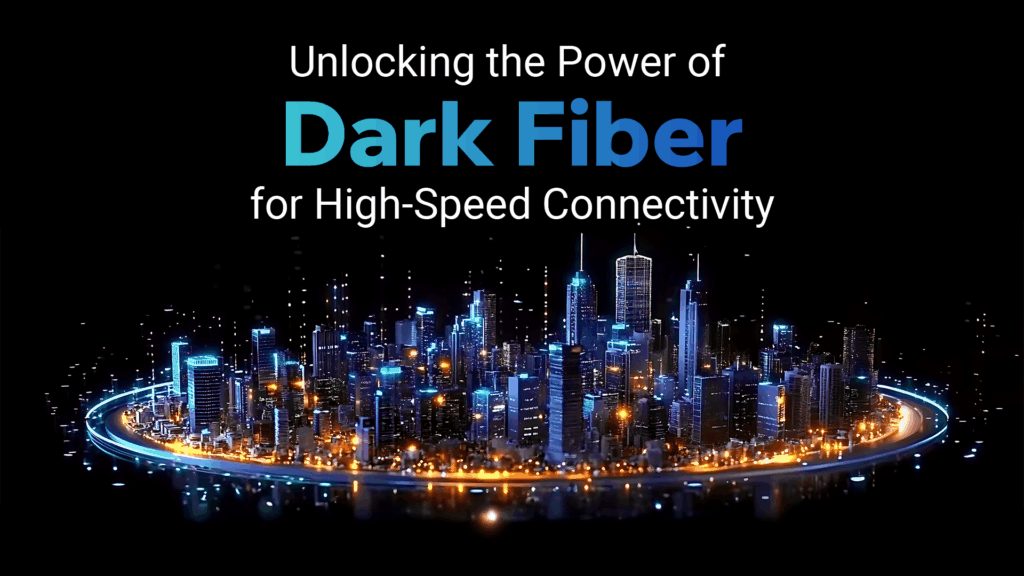
In an era defined by data, the demand for high-speed, scalable, and ultra-secure connectivity has never been greater. While standard internet service is often sufficient, a growing number of large enterprises, data centers, and institutions are turning to a powerful, yet often misunderstood, solution: 裸光纤.
More than just a high-capacity cable, dark fiber is a private digital superhighway, offering unprecedented control and near-limitless potential.
What Exactly is “Dark Fiber”?
The name “Dark Fiber” sounds mysterious, but the concept is simple.
- 裸光纤 refers to installed, but currently unused (or “unlit”), optical fiber cables. They are called “dark” because no light signal (data) is being transmitted over them.
- In contrast, Lit Fiber is the standard service you lease from a carrier, where they provide the active equipment to send light signals and manage the network for you.
When a company leases dark fiber, they are essentially renting the bare glass strands. It is then up to the customer to install their own optical transmission equipment (like lasers and multiplexers) at either end to “light” the fiber and turn it into a private, operational network.
The Key Advantages: Why Dark Fiber Shines
Opting for dark fiber is a strategic decision driven by the need for ultimate performance, control, and future-proofing.
1. Near-Unlimited Scalability
This is dark fiber’s most compelling feature. With standard services, your capacity is capped by the service plan you purchase. With dark fiber, the limit is only the electronic equipment you attach to it.
- Future-Proofing: You can start at 10 Gbps and scale up to 100 Gbps, 400 Gbps, or even higher simply by upgrading your endpoints using technologies like DWDM (Dense Wavelength Division Multiplexing). There is no need to wait for a service provider upgrade or re-lay physical cables.
2. Absolute Network Control
Dark fiber puts you in the driver’s seat of your network architecture.
- Customization: You select the equipment, the protocols, the routing, and the Quality of Service (QoS) policies. This level of control allows you to fine-tune the network for specific applications, such as low-latency financial trading or massive data center replication.
- Low Latency: Since your data travels a dedicated, direct physical path with fewer intermediate hops, dark fiber delivers some of the lowest latency connections possible—critical for real-time applications and cloud synchronization.
3. Maximum Security and Isolation
In an age of constant cyber threats, a private network is an invaluable asset.
- Dedicated Infrastructure: Your data stream is physically isolated; it never mixes with traffic from other customers. This dramatically reduces the surface area for cyberattacks.
- Enhanced Encryption: You can implement your own, high-level, end-to-end encryption protocols, ensuring complete confidentiality for sensitive information (e.g., in healthcare or finance).
4. Long-Term Cost Predictability
While the initial upfront investment in equipment and expertise is significant, the long-term cost model is often more favorable for high-bandwidth users.
- Fixed Cost: Instead of paying ever-increasing monthly fees for bandwidth increases (common with lit services), the primary operational cost for dark fiber remains relatively fixed, making it a cost-effective solution for massive data volume over a multi-year horizon.
Who is Dark Fiber For?
Dark fiber is not a solution for every business, but it is indispensable for those with extreme network requirements:
- Data Centers & Cloud Providers: Need to connect facilities for disaster recovery, real-time data replication, and massive data transfers.
- Financial Institutions: Require ultra-low latency for high-frequency trading and secure, isolated networks for compliance.
- Large Enterprises with Multiple Sites: Use dark fiber to create a seamless, private Wide Area Network (WAN) between headquarters, branch offices, and corporate data centers.
- Research & Educational Institutions: Need to support data-intensive scientific computing and collaborative research projects.
Dark Fiber vs. Lit Fiber: A Quick Comparison
| Feature | Dark Fiber (Leased Fiber) | Lit Fiber (Managed Service) |
| Capacity & Speed | Unlimited (capped only by customer’s equipment) | Limited by provider’s service plan |
| Control | Full control (customer manages all equipment) | Minimal control (provider manages all equipment) |
| 安全性 | Highest isolation (dedicated, private strands) | High (but shared infrastructure) |
| Upfront Cost | High (must buy equipment) | Low (equipment is provider’s) |
| Long-Term Cost | Favorable for massive bandwidth users | Increases as bandwidth demand rises |
| Required Expertise | High (needs in-house IT staff) | Low (fully managed by provider) |
Conclusion
Dark fiber represents the pinnacle of network connectivity. It’s not just about speed; it’s about ownership, scalability, and security. For organizations that view their data network as a mission-critical asset, investing in dark fiber is less of an expense and more of a strategic foundation for long-term digital growth and innovation. If your bandwidth needs are soaring and you demand absolute control over your data’s journey, it might be time to bring the power of the dark fiber highway to light.
